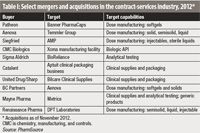Acquisitions Reshape the Bio/Pharm Services Industry
The quest to build critical mass and broaden capabilities has been a key factor in deal-making.
The year 2012 has been an important year for acquisitions in the bio/pharmaceutical CMC (chemistry, manufacturing, and controls) contract services industry. Some of the premier names in the industry have been involved in major deals, either as buyers or sellers. The pace and nature of these deals suggests that there are more to come in the next several years.

(JONATHAN EVANS/PHOTODISC/GETTY IMAGES)
PharmSource has counted at least 20 acquisitions of CMC service providers in 2012 through the end of November 2012 (see Table I). Some of the larger and more significant deals are listed in the accompanying table. There seem to be a wide variety of underlying drivers for the acquisition activity, but several really stand out.

Jim Miller
Size matters
Arguably, the most important of these drivers has been the pursuit of large size. Company size and breadth of capabilities has clearly been a major criterion in the awarding of strategic sourcing relationships for clinical research services by global bio/pharmaceutical companies. Size reflects broad scope, financial strength, and the ability to achieve economies of scale. Although the strategic sourcing trend is still evolving in manufacturing, where CMOs are battling with in-house capacity, it has penetrated the clinical packaging and analytical services segments of CMC services, where large companies are clearly favored.

Table I: Select mergers and acquisitions in the contract-services industry, 2012*
Another advantage of size is that larger companies get the attention of the investor community, which provides investment capital for growth and the opportunity for current owners to realize the value of their investments. Whether the plan is to eventually sell equity to the public, or sell to another private equity firm, the size of a company is important to the investment community, which likes to put large amounts of capital to work in any given deal. Even if a CRO or CMO is a business unit of a larger, diversified company, size is likely to be critical to getting senior management attention and access to corporate capital for investment.
Broader capabilities
Another driver of acquisition activity in 2012 has been the desire of companies to position themselves in segments of the market that promise more robust growth or better margins than more mundane services. Highly desirable opportunities have included services that support development and manufacture of biopharmaceuticals (both APIs and injectable drug products) and drug-delivery technologies that can be broadly applied such as softgels. Examples of deals driven by these considerations include the acquisitions of Banner PharmaCaps and Aenova, both of which are major players in the softgel business, and Sigma Aldrich's acquisition of BioReliance, a market leader in services for development of biologics.
When the objective is to add important capabilities in critical markets, deals can be strategically important even if they are not large. So-called "bolt-on" acquisitions enable CMOs and CROs to add skills and facilities quickly and with immediate payback and are not disruptive to the acquirer's core operations. A recent example is the acquisition of the UK biosafety laboratory Vitrology by SGS Life Sciences, which extended SGS's offerings for the testing of biopharmaceuticals.
A third rationale that has underlain several recent acquisitions has little to do with contract services. CMOs are being acquired to serve as platforms for building generic products businesses. DPT Laboratories, Confab, and Metrics have all been acquired by companies whose ultimate objective is to build a generic or specialty pharmaceutical business by pairing acquired manufacturing capacity with in-licensed or acquired products. Those companies, well-respected in their respective service areas (semisolids and liquids for DPT and Confab, solid dose and analytical for Metrics), will maintain their successful contract services businesses but also will take on more production of proprietary products.
More to come
Despite, or even thanks to, the recent turmoil in the world economy, we expect to see more acquisitions of CMC service providers in the near future. Not only are there clear rationales for making acquisitions of CMC companies, but there also seems to be plenty of resources available to do them. Many private-equity firms are capable of financing these deals, and they especially like the opportunity to consolidate highly fragmented industries, such as CMC development and manufacturing services. Banks in North America, even some European banks, are eager to help fund these deals in an environment where overall loan demand is depressed.
The CMC services industry, especially contract manufacturing, will benefit from having a core of large global companies capable of serving global bio/pharmaceutical companies. Catalent, which was assembled through acquisitions, has already topped the $1 billion mark, and Patheon has gotten there with the Banner acquisition. Aenova and Aesica, both based in Europe, have stated their intention of getting to the $1 billion mark, and Aenova is more than halfway there after its Temmler acquisition.
Acquisitions will continue to reshape the CMC services industry, and they are a sign that the industry is reaching a new level of maturity.
Jim Miller is president of PharmSource Information Services, Inc., and publisher of Bio/Pharmaceutical Outsourcing Report, tel. 703.383.4903, Twitter@JimPharmSource, info@pharmsource.com, www.pharmsource.com.

Drug Solutions Podcast: A Closer Look at mRNA in Oncology and Vaccines
April 30th 2024In this episode fo the Drug Solutions Podcast, etherna’s vice-president of Technology and Innovation, Stefaan De Koker, discusses the merits and challenges of using mRNA as the foundation for therapeutics in oncology as well as for vaccines.
Entering New Domains for 3D Printing of Drug Products
April 6th 20253D printing of personalized medications is currently possible under existing compounding regulations, offering enhanced process control through automation. But new legislation coming in 2025 will allow 3D printing as part of a distributed manufacturing framework.